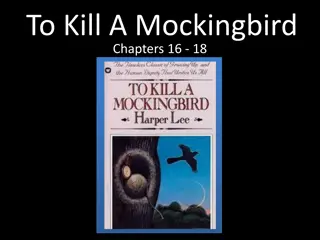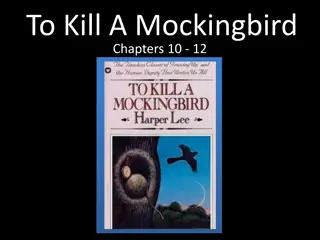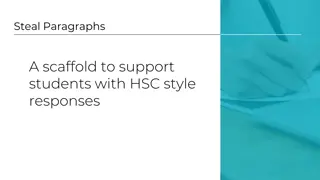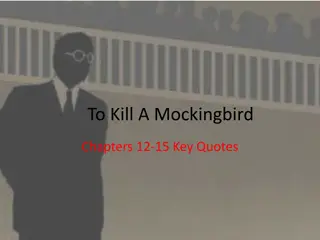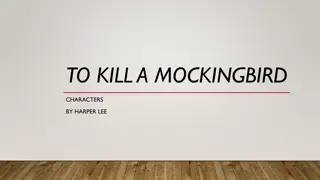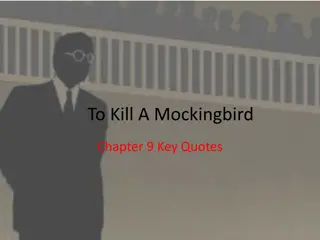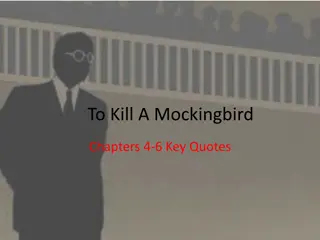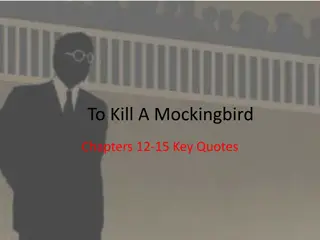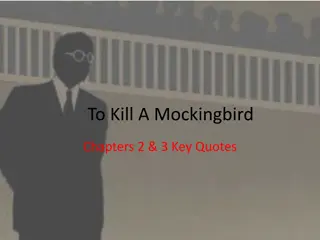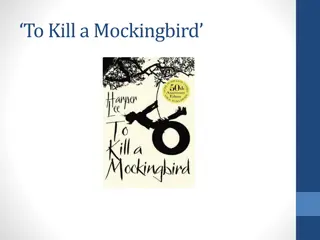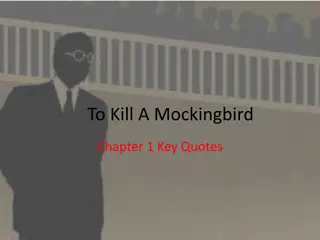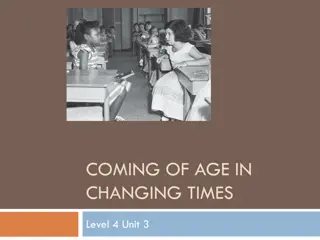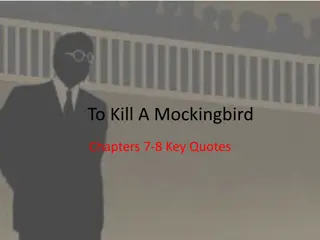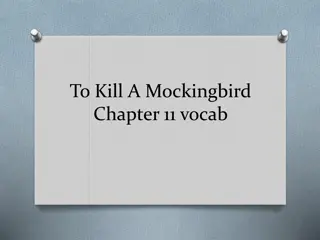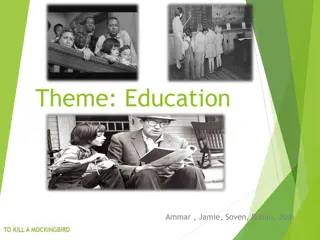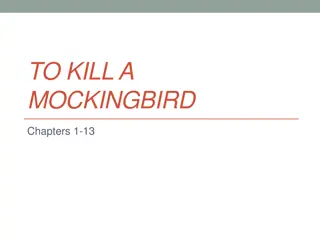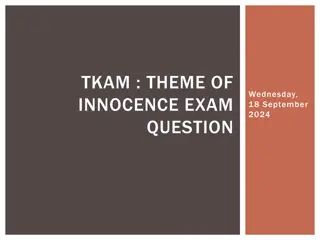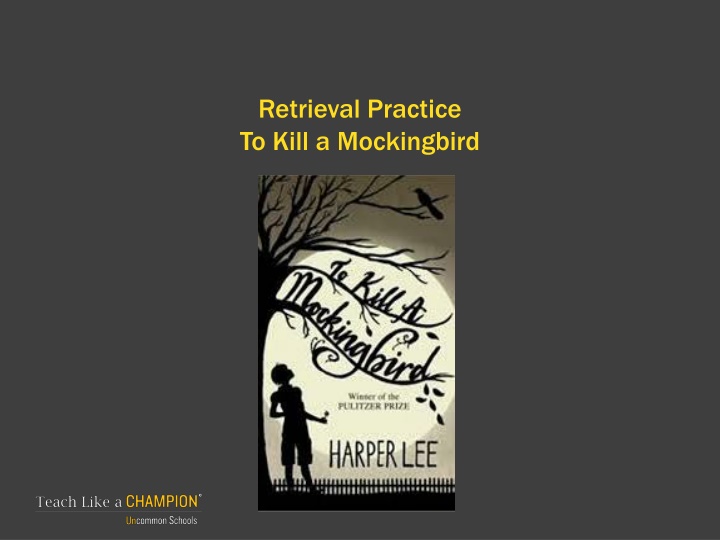
Exploring Key Concepts in 'To Kill a Mockingbird' through Retrieval Practice
Enhance your understanding of the themes and historical context in "To Kill a Mockingbird" with targeted retrieval practice questions and detailed answers. Uncover insights about caste systems in the South, characters like Simon Finch, perspectives on Northerners, and significant events like the Civil War and Reconstruction era. Dive into the complexities of the Jim Crow Era, the Great Depression, and more through engaging learning exercises.
Download Presentation

Please find below an Image/Link to download the presentation.
The content on the website is provided AS IS for your information and personal use only. It may not be sold, licensed, or shared on other websites without obtaining consent from the author. If you encounter any issues during the download, it is possible that the publisher has removed the file from their server.
You are allowed to download the files provided on this website for personal or commercial use, subject to the condition that they are used lawfully. All files are the property of their respective owners.
The content on the website is provided AS IS for your information and personal use only. It may not be sold, licensed, or shared on other websites without obtaining consent from the author.
E N D
Presentation Transcript
Retrieval Practice To Kill a Mockingbird
Retrieval Practice: Lesson 6 1. What is a caste? 2. What group was at the top of the Southern caste system? 3. Who was at the bottom? 4. Who was Simon Finch? What do we know about Simon? 5. How did Southerners typically feel about Northerners? Take 3 minutes to complete these questions 6. What is a Yankee? 7. What is retrospective narration? 8. Scout often speaks ironically. What does that mean?
Retrieval Practice Answers: Lesson 6 1. Caste: social ranking (or hierarchy) based on ancestry and race 2. The white aristocratic class was at the op of the Southern caste system. 3. Impoverished people were at the bottom; poor White people had slightly higher status than most Black people because of racism 4. Simon Finch is an ancestor of Scout s. He owned slaves, a homestead on the Alabama River, made a large amount of money in manufacturing medicines and died a wealthy man 5. Southerners typically felt hostility toward Northerners. 6. Yankee: Northerners with different cultural views than Southerners. 7. Retrospective narration: a story told from the point of view of a character looking back on past events
Retrieval Practice Answers: Lesson 6 (continued) 8. Irony refers to a moment in which what appears to be true and what is actually true, differ, often reflected in Scout s narration of events. Self-score: ______ /8
Retrieval Practice: Lesson 9 1. In the Civil War, who formed the confederacy? 2. Who formed the Union Union army? 3. What was the Emancipation Proclamation of 1863? What president issued it? 4. What was Reconstruction? 5. Carpetbaggers traveled to the South during Reconstruction. Who were they? 6. To Kill a Mockingbird is set during the Jim Crow Era. What does that refer to? 7. The Great Depression began after the stock market collapsed in 1929. What happened as a result of this crash? 8. What was The War of Northern Aggression? Can you think of a character in our novel who might call it that? Take 3 minutes to complete these questions
Retrieval Practice Answers: Lesson 9 Southern states 1. 2. Northern states 3. The Emancipation Proclamation freed enslaved people; Abraham Lincoln 4. Reconstruction: time period when efforts were made to rebuild the war-torn Southern states, unify the nation, and integrate freedmen into society 5. Carpetbaggers: Northerners who sought profit from Reconstruction 6. The Jim Crow Era refers to the time period when lawmakers passed laws to enforce segregation. 7. Economy collapsed, many lost their life savings, unemployment became widespread, poor people began to rely on charity for survival 8. Self-Score ______/8
Retrieval Practice Answers: Lesson 9 (Continued) 8. The War of Northern Aggression: Name for Civil War used by many Southerners; <Include characters you ve discussed in class that might use this term> Self-Score ______/8
Retrieval Practice: Lesson 12 1. What is one feature of a retrospective narrative retrospective narrative? ? 2. What s another feature of a retrospective narrative retrospective narrative? ? 3. What is Southern Gothic Southern Gothic? 4. What is something from To Kill Mockingbird that you could describe as Southern Gothic Gothic? Southern 5. What is satire satire? 6. What is one example of Harper Lee using satire satire? 7. What is irony irony? 8. Give an example of something ironic ironic from the novel. Take 3 minutes to complete these questions
Retrieval Practice Answers: Lesson 12 1 and 2. R Retrospective Narrative: etrospective Narrative: told from the point of view of a character looking back on past events; uses first-person; past tense narration 3. Southern Gothic Southern Gothic: : genre of mystery and horror set in the American South, that critiques Southern society, often using absurd characters 4. <Insert examples you ve discussed in class including the eerie setting, the moon, Mr. Radley s reaction to hearing a person in his collard patch as a critique on Southern racism in the 1930s> 5. satire satire: : use of humor, irony, or sarcasm used to critique the flaws of something, often government or society 6. <Insert examples of satire you ve discussed as a class> 7. irony irony: : a moment in which what appears to be true and what is actually true differ 8. <Insert examples of irony you ve discussed as a class>
Retrieval Practice: Lesson 17 1. What is an archetype archetype? 2. What Southern female archetype archetype have we discussed? 3. Before the Civil War (Antebellum South), wealth was created by what type of economy economy? 4. What is a plantation plantation? 5. What system was called slavery by another name slavery by another name ? 6. Did tenant farmers tenant farmers generally produce more or less wealth, compare to say, a plantation owner? plantation 7. What was The New Deal The New Deal? Take 3 minutes to complete these questions 8. Which president president was responsible for it? 9. 9. Challenge: Challenge: What did this president famously tell the nation at his inauguration in 1933?
Retrieval Practice Answers: Lesson 17 archetype: : a classic example of a character or thing that recurs throughout literature and/or culture 1. archetype 2. Southern Belle - a young women from the aristocratic classes of the Antebellum South (period before slavery ended). A Southern Belle was beautiful, flirtatious, and hospitable in every situation 3. slave economy 4. plantation plantation: : large agricultural properties that produced cash crops using slave labor 5. sharecropping system 6. Tenant farmers Tenant farmers produced significantly less wealth than a plantation owner. 7. The New Deal The New Deal: : laws and government relief projects that employed millions of unskilled laborers in construction 8. Franklin Delano Roosevelt 9. Challenge: The only thing we have to fear is fear itself.
Retrieval Practice: Lesson 22 1. Let s consider the bottom classes of the Southern caste system the bottom? Southern caste system. Which groups are at 2. Of those at the bottom, who has more power? Why is this? 3. How did many middle class whites try to set themselves apart from the poor? 4. What are Jim Crow juries Jim Crow juries ? 5. What is Lynch law Lynch law ? 6. What examples of Lynch law Lynch law have we seen in the novel? 7. What does the Klan the Klan refer to? Take 3 minutes to complete these questions 8. What was the goal of the Klan the Klan ? 9. 9. Challenge Challenge: Is Atticus s experience typical or atypical of whites who openly challenged racism during the time?
Retrieval Practice Answers: Lesson 22 1. Impoverished people were at the bottom of the Southern caste system.. 2. Of those at the bottom of the Southern caste system, poor White people had slightly higher status than most Black people because of racism. 3. Many middle-class Whites tried to set themselves apart from the poor by trying to claim they were morally superior. 4. Jim Crow juries : Jim Crow juries : all White juries 5. Lynch law Lynch law : charged of crimes themselves : violent mobs murder Black people accused of crimes, without being 6. <Insert examples of lynch law you have discussed as a class> 7. T The Klan he Klan refers to the Ku Klux clan, a white supremacist organization 8. The goal of the Klan from gaining power in society and government the Klan was to use acts of terror and violence to prevent Black people
Retrieval Practice: Lesson 27 1. How does Jem become more cynical cynical after Tom s trial? 2. At the beginning of Chapter 27, Scout describes Bob Ewell being fired from the WPA What is this a reference to? WPA. 3. Does Mayella Ewell fit into the archetype archetype of the Southern Belle? Why or why not? 4. Harper Lee includes an allusion and why? allusion to Hitler and the Nazi party. When does she do this 5. When Scout asks Jem about Miss Gates s hypocrisy, he gets upset and tells Scout to never talk to him about Tom s trial again. How does this show his cynicism cynicism? Take 3 minutes to complete these questions
Retrieval Practice: Lesson 27 1. <Insert examples you have discussed as a class including Jem saying that he now understands why Boo Radley stays inside all the time> 2. 2. WPA: WPA: Works Progress Administration, part of the New Deal which employed millions of unskilled laborers 3. Mayella Ewell does not fit into the archetype and Southern Belles were associated with the aristocratic class. archetype of Southern Belle because she is poor, 4. The allusion to the Nazi Party, illustrates Scout s awareness ofMiss Gates s hypocrisy in disapproving of prejudice in Germany but holding deeply prejudiced views of black people in Maycomb 5. It illustrates his new, general distrust of the world. The topic of Tom s trial is so painful for Jem, he cannot even discuss it with Scout.
Retrieval Practice: Lesson 29 1. What biblical allusion death? allusion does Heck Tate make when arguing with Atticus about Bob s 2. What does this phrase mean? 3. Harper Lee uses satire example of Lee s satire satire to make some important statements about society. What is one satire that we ve studied? 4. What was she trying to critique in that example of satire satire? 5. Do you think Scout has become cynical cynical like Jem? Why or why not? Take 3 minutes to complete these questions
Retrieval Practice Answers: Lesson 29 1. Let the dead bury the dead. 2. In this case, he means to let the past go (Bob s death) and do what is best for the living (in this case to protect Boo Radley from public scrutiny). 3. <Insert examples you ve discussed as a class> 4. <Insert examples you ve discussed as a class> 5. <Answers will vary; ensure that students back up their answers with evidence>



